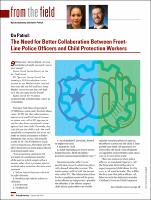Please use this identifier to cite or link to this item:
https://hdl.handle.net/20.500.12202/4723| Title: | On Patrol: The Need for Better Collaboration Between Front- Line Police Officers and Child Protection Workers. |
| Authors: | Lamberly, Edna Pollack, Daniel 0000-0001-7323-6928 |
| Keywords: | children & youth Collaboration Police Criminal investigations Child abuse & neglect Social workers |
| Issue Date: | Dec-2017 |
| Publisher: | American Public Human Services Association-APHSA |
| Citation: | Pollack, Daniel ; Lamberly, Edna. (December 2017). On Patrol: The Need for Better Collaboration Between Front- Line Police Officers and Child Protection Workers. Policy & Practice 76(6): 30, 38. |
| Series/Report no.: | Policy & Practice;76(6) |
| Abstract: | The New York Police Department (NYPD) has a radio code1 for child abuse cases (10-35), but this radio transmission is rarely used by Central because no parent ever calls a 911 operator to say that they have committed a crime against their own child.The NYPD Patrol Guide General Aided Cases, Procedure 216-01, offers guidelines to assist police officers in defining aided cases: "Any occurrence coming to the attention of a uniformed member of the service which requires that a person, other than a prisoner, receive medical aid or assistance because such person is: a. Sick or injured (except vehicle or bicycle collision). b. Dead (except vehicle or bicycle collision). c. Lost person. d. Mentally ill. e. An abandoned, destitute, abused or neglected child. f. Runaway child. g. Adult requiring care due to arrest, hospitalization, death of parent/ guardian/person responsible for care.There are instances when police officers, as mandated reporters, call the Statewide Central Registry to report suspected child abuse. |
| Description: | Legal notes |
| URI: | https://search.proquest.com/docview/2037355058?accountid=15178 https://hdl.handle.net/20.500.12202/4723 |
| ISSN: | 1942-6828 |
| Appears in Collections: | Wurzweiler School of Social Work: Faculty publications |
Files in This Item:
| File | Description | Size | Format | |
|---|---|---|---|---|
| art APHSA On patrol The need for better collaboration between front-line police officers and CPS workers 12-4-17.pdf | 211.38 kB | Adobe PDF |  View/Open |
This item is licensed under a Creative Commons License

